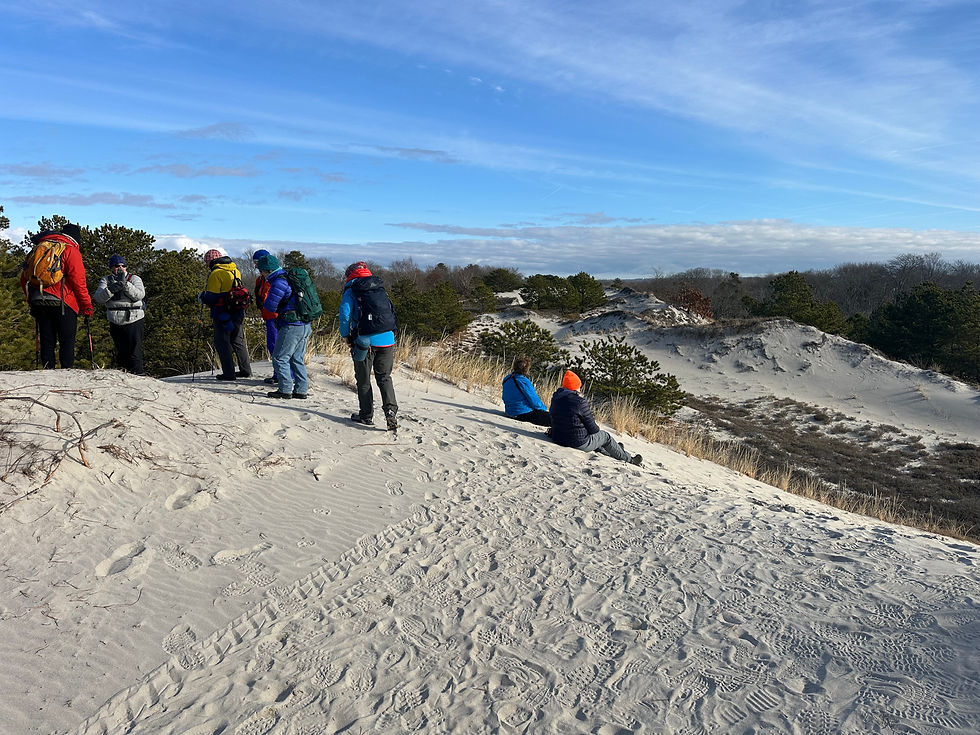Tracking on the Dunes
- Kyle Forest
- Dec 16, 2024
- 4 min read
We gathered on a blue sky morning and spotted an enormous bird perched on the boardwalk railing. Was it a Goshawk, a Red tail? It was just far enough away that we couldn't quite tell. And as we stood with excitement in the crisp morning air, it flew and the enormous bird, puffed up in the cold seemed to lose half of its bulk and turn into a Cooper's Hawk with a flap-flap-flap pause and long tail. I'm not sure if we ever got an ID on our friend but it was an important reminder in being patient and open to possibilities.
The humans conveniently walk in the middle of the sandy paths, leaving plenty of opportunity for tracking along the sandy margins before the phalanx of false heather-woolly beach heather (Hudsonia tomentosa).

At the Top left of the photo you can see the 1-1-2 bound leaping into the sitting/still position of a vigilant Eastern Cottontail.

I couldn't find a perfect match for the creator of this bird nest, but what I am seeing is the outer nest made of coarse twigs, while the inner lining is made of grass, pine needles, and lichens. The outer dimension is 5 inches. It seems to be pretty well woven and sturdy so I didn't think it was a Mourning Dove. It fell out of the pine tree, so it probably wasn't a Catbird, Mockingbird, thrush. Maybe a Blue Jay? It is a bit conical. Maybe a Grackle? But a bit small for a Blue Jay or Grackle- being only 5-6 inches wide.

Katie pointed out how the sand captured the detail in the Deer's hoof morphology. The hoof wall forms the bold point on the cleave. The pad is on the interior of the cleave, with the subunguis separating the two.

This galloping Coyote left a beautiful front track with a bold Metacarpal. In Coyotes, the metacarpal pad tends to be wider than the width of the leading two toes. The Coyote didn't seem as interested in the Earth Star Mushroom as we were (to the upper right of the track)

The landscape was riddled with these magnificent wind blown sand mandalas.

We had a thorough discussion on Walk vs. Trot vs. Side Trot. A walk is a zigzagging pattern. The animal is moving slowly through the landscape and always has 3 feet on the ground and if it freezes to listen at any moment, its body position is in a stable tripod. A trot is a faster, bouncy gait in which 2 feet at a time are landing almost in a perfect line. If the animal needed to stop fast, it would need to put 1 additional foot down to stabilize its position. A side trot is similar, in that it is a bouncy gait with only 2 feet down at any one time, but it is even faster. The animal is trying to increase its stride length beyond a regular trot by moving their hind quarters to the side and extending their hind feet beyond their front feet. It would be like one of us jogging and then decide to run, so we increase how long each stride is to increase our speed.

We took a break for lunch and basked in the sun.

There were a number of bird tracks and this one had an added complexity of favoring their left foot and so we theorized that they may have had an injured right foot. In the photo below, you can see the progression from a really unusual looking track to a more normal set of Junco tracks.

This set of tracks is a bird that has toes 2 and 4 really close to the middle toe 3 so the tracks look really narrow.... although it was longer than a Chickadee but smaller than a typical Blue Jay. I tended to think it was the latter. Comment on the blog post if you have another guess!

The curvy toes of the morning dove in a walk with a little danish pastry scat near the tip of my measuring tape.

The Junco's had a feeding frenzy with the dune grass seed, and in another area, the seeds of the Gray Birch.

This little 1 inch track is so perfectly in line that it is hard to tell what is left and right. Toe 1 is missing all together. Katie noticed how toe 2 set down and apart from toes 3 and 4. We thought the tracks best resemble the pipping plover but I'm curious if they have migrated already? Comment at the bottom of the blog webpage.

Cindy pointed out these tiny scratches on the beach and they are so small but we think they are a very very small pet dog in a full gallop whose stride looks about the size of two of my boot lengths.

This brave mouse seemed to find a nice house far away from their feeding grounds in the dune grass. They had quite the stockpile of some sort of thistle. Good luck little one!

Thank you to everyone for the great day at Crane's Beach. It is such a blessing to have this land preserved for all to appreciate!




Great summary of the day, Kyle! Though I think in the future we should attempt to let Kyle take pictures before walking all around the tracks.
Just looked at recent MA bird sightings and Sanderlings were mentioned. No Piping Plovers.
Great day! Thanks everyone, especially Kyle and Hillary. - Cindy